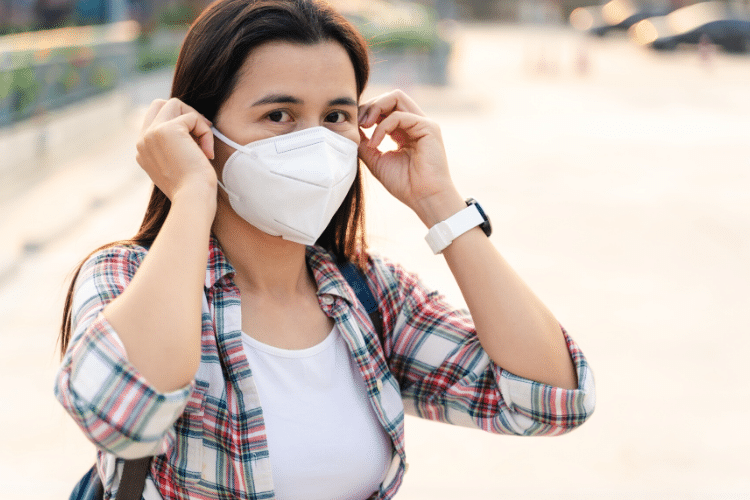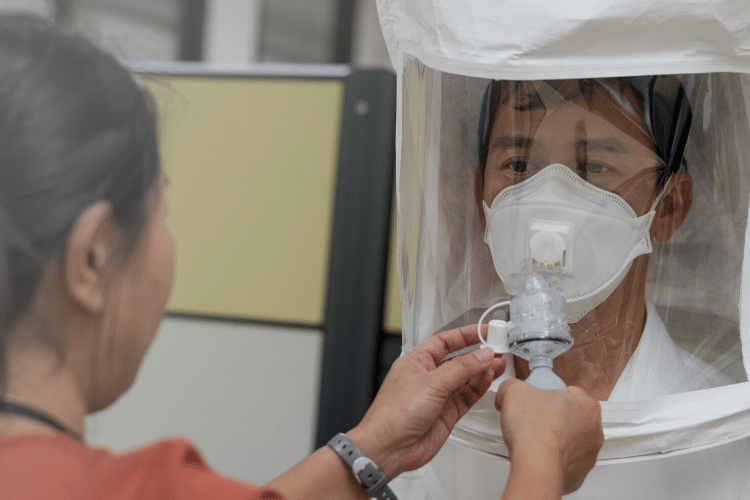Respirators have long been used in both industrial and healthcare settings to protect workers from airborne hazards. In recent years, their use has become more widespread across a range of workplaces. Respirators like N95s or KN95s are designed to form a tight seal on the face, helping to prevent harmful airborne agents from being inhaled by the wearer.
But how can you be sure a respirator is providing the protection it’s meant to?
The answer: a fit test.
A respirator fit test is the most effective way to confirm whether a tight-fitting respirator fits properly and is safeguarding workers against hazardous airborne substances. And in Canada, it’s also required by law.
What is mask fit testing?
A “mask fit test” is used to determine if a respirator such as an N95 or KN95 mask is a good fit for the user’s face. It is performed on the person who is going to wear a respirator. Achieving a good fit is necessary for the respirator to work properly.
What is a good fit? A mask that forms a tight seal against the face of the wearer. Fit testers use specialized equipment to make this determination.
Fit testing is often required by occupational health and safety legislation as part of a sound overall respiratory protection program, which should also include a policy, procedures, and training.
Why is a fit test important?
A fit test is important because this is the best way to determine if a mask fits properly and is working by creating an adequate seal. A properly-fitted respirator helps protect workers from hazardous airborne particles that can lead to illness or disease.
In Ontario, respirators are required as part of organizations’ respiratory protection programs if “exposure to these hazards cannot be avoided or effectively controlled” through other methods of hazard control such as elimination or engineering controls.
A fit test is also required by Canadian and Ontario legislation. For example, Ontario’s Occupational Health and Safety Act (OHSA) states that, “An employer who provides a worker with a respirator shall provide training and instruction to the worker in the care and use of the respirator before the worker first uses the respirator.”
What are the risks of wearing a mask that doesn’t fit properly?
The most important thing to remember is that if a mask doesn’t fit properly and is not sealed, it is not doing its job. This means that if a worker has not been fit tested on the mask they are going to use, there is no assurance that it will keep them safe or prevent airborne particles from making them sick.
Which respirators require fit testing?
All tight-fitting respirators require a seal in order to work. If an employer requires a worker to wear the following types of respirators, a fit test is needed:
- Filtering facepieces such as N95 or KN95 masks
- Half-face respirators
- Full-face respirators
- Self-Contained Breathing Apparatus (SCBA’s)
What is the difference between a tight-fitting respirator and a loose-fitting respirator?
A tight-fitting respirator such as an N95 or KN95 mask needs to be sealed against the wearer’s face in order to properly work. Loose-fitting respirators usually cover the entire face or entire head and tend to work by pumping filtered air into the mask or are connected to a separate air supply like an oxygen tank. These respirators are usually hoods or helmets.
When is respirator fit testing required?
According to the Canadian Standards Association (Z94.9.1.6) every worker using a respirator must be fit tested if they are required to wear one.
If a worker has never had a fit test before and if they are required to wear a respirator, they need one in accordance with the Canadian Standards Association (CSA) and Ontario’s Occupational Safety Act (OHSA). As well, workers need a fit test:
- At least every two years according to the CSA (Z94.9.1.6)
- Whenever changes to the user’s physical condition could affect the respirator fit such as due to weight gain or loss, surgery, or major dental work (CSA 94.7.1.3.d)
- If they are using a new respirator make or model
As well, your organization may have additional policies that require more frequent fit testing. The CSA (Z94.7.1.3) recommends that workers be fit tested annually.
What are the most common ways to test a mask’s fit?
You may have heard of “qualitative” fit testing and “quantitative” fit testing. Both test the effectiveness of a mask’s fit. A qualitative fit test is based on the wearer’s ability to taste a harmless solution at very low levels. A quantitative fit test uses a specialized machine to measure the particles inside and outside the mask.
What is a qualitative respirator fit test?
A qualitative fit test uses a solution to test if a respirator fits. For the first step of the test, the person being tested will put a special hood over their head, likely similar in appearance to the one in the image below. Importantly, for this first step the person being tested does not wear their respirator.
Next, the tester will spray a sweet or bitter-tasting solution into the hood to determine your ability to detect the solution. This is the sensitivity solution.
If at first the person being tested does not taste the solution, the tester will continue to gradually spray more solution until it can be tasted. During this step the tester will record your sensitivity to the solution.
The second step can begin once the person being tested has removed their hood and can no longer taste the bitter solution. For the second step, the person being tested must don the respirator being fit tested.
Once the tester is confident there is a good seal, the person being tested will once again put on the hood. The tester will then spray another solution. This is the fit testing solution.
The tester will have the person being tested go through several different exercises such as normal breathing, talking, and moving their head side to side while the solution is being sprayed. This is to ensure that the mask will continue to fit in real-world use.
If the person being tested can taste the solution then the respirator is not a good fit. If they cannot test the solution, the mask is a good fit.
What is the solution used in qualitative fit testing?
The solution is a strongly-flavoured liquid that is perfectly harmless. The most commonly used solution is Bitrex—the most bitter substance on earth. Other times, the solution is saccharin—an artificial sweetener.
What is quantitative respirator fit test?
A quantitative fit test is conducted by an operator using an approved quantitative fit testing machine such as the PortaCount Respirator Fit Tester.
Just like in qualitative fit tests, the person being tested will be asked to go through different exercises such as talking, turning their head from side to side, and nodding to help make sure the mask will continue to fit over the course of an employee’s workday. These exercises are required by the Canadian Standards Association (CSA) (Z94.B.1.5.2).
Throughout the test, the machine takes measurements of the level of particles inside the mask compared to the ambient air outside of the mask. If there is high particle count inside the mask, then a good seal has not been achieved. If there is a very low particle count, the mask is a good fit.
How often do you need mask fit testing?
Respirator fit testing is required before you use a respirator for the first time, and at least once every two years after that. Fit testing must also be repeated any time there is a change that could affect the fit of the respirator—such as switching to a different make or size, or experiencing significant weight loss that may alter the shape of your face.
How long does a fit test take?
There are a lot of factors that can make the process go faster or slower such as if each worker needs to have multiple masks tested.
In general, it takes about 10 minutes per person to conduct a quantitative fit test and 15 to 20 minutes for a qualitative fit test.
Is there anything workers need to do to prepare for a fit test?
There are a few things workers need to do before their test. In order to ensure accurate results for a qualitative fit test, anyone getting a fit test cannot eat, drink, chew gum, or smoke in the half-hour before a test. Drinking water is fine.
For a quantitative fit test, the person being fit tested cannot smoke in the half-hour before the test.
Employers need to ensure that any worker being fit tested is healthy enough to wear a respirator. This is done through a Medical Assessment. For example, OSG will not conduct a fit test unless an employer confirms that all employees to be fit tested have already been medically assessed as healthy enough to wear a respirator. If a worker has a condition that prevents the use of a respirator, the employer will need to find an alternative way to keep the worker safe.
As well, the Canadian Standards Association (CSA) (Z94.4) states that anyone using a respirator or being fit tested, either qualitatively or quantitatively, must be clean-shaven where the respirator seals against the face. This is because facial hair can prevent a proper seal. The CSA also suggests that workers need to shave their face seal area “within the last 24 hours prior to the fit test.”
Ontario Regulation 185/19 Section 12.3 of Ontario’s Occupational Health and Safety Act (OHSA) also states that anyone being fit tested must not have facial hair that prevents the proper seal of a tight-fitting respirator.
Finally, it is important that the person getting the fit test is wearing anything they would normally wear to work, such as other PPE or glasses, to ensure that the mask continues to fit during typical working conditions.
What happens if a worker passes a fit test?
If a worker passes a fit test, this indicates that the respirator they were tested on is a good fit for them. Usually, the participant is given documentation, such as a wallet card, indicating they passed their fit test for the make and model of respirator they wore during the test.
This means they will be able to use that make and model of respirator for up to two years. However, they will need another fit test sooner “whenever changes to the user’s physical condition could affect the respirator fit” CSA (Z94.7.1.3).
What happens if a worker fails a fit test?
If a worker fails their test, then this means that the respirator is not a good fit or that a good seal was not achieved. If adjusting the respirator does not achieve a better seal, then the worker should not use that make and model of respirator. For this reason, some organizations may choose to have their workers tested on multiple sized masks during their fit test to help ensure their workers find the right respirator.
If there isn’t a mask available that a worker can pass their fit test on, they should talk to their supervisor or employer about next steps. This could include finding a different make and model of respirator.
Does OSG conduct respirator fit tests?
Yes, regularly. Our team can conduct fit tests at your place of work. For more information or to book a fit test please fill out our Respirator Fit Testing form.
Will workers be provided with masks if OSG conducts a fit testing?
No, your employees must be tested on the masks they will be wearing.
How can I book a respirator fit test?
To book your Respirator Fit Test please complete this form and our team will be in touch with scheduling availability.

